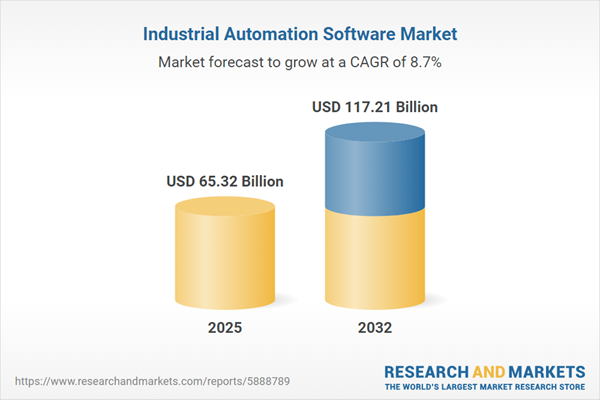Speak directly to the analyst to clarify any post sales queries you may have.
The industrial automation software market is evolving rapidly as manufacturers prioritize digital transformation, process optimization, and resilience across complex operational landscapes. Executive decision-makers must monitor emerging technologies, evolving regulations, and regional trends to capture growth opportunities and navigate competitive dynamics.
Industrial Automation Software Market Snapshot
Market size and growth: The industrial automation software market grew from USD 60.02 billion in 2024 to USD 65.32 billion in 2025. It is projected to achieve a CAGR of 8.72% and reach USD 117.21 billion by 2032.
Industry context: This growth reflects manufacturers’ emphasis on integrating Industry 4.0 solutions, optimizing total cost of ownership, and building robust, data-driven infrastructures. Expanding adoption of IIoT, artificial intelligence, and digital twin technology is driving real-time insights and predictive maintenance.
Scope & Segmentation
- Deployment Modes: Cloud; On-Premises
- Organization Sizes: Large Enterprises; Small and Medium Enterprises
- Service Types: Managed Services (Maintenance, Remote Monitoring); Professional Services (Consulting, Implementation, Training)
- End-User Industries: Discrete Manufacturing (Aerospace, Automotive, Electronics); Process Manufacturing (Chemicals, Food and Beverage, Oil and Gas)
- Product Types: Distributed Control Systems (DCS), Human-Machine Interfaces (HMI), Manufacturing Execution Systems (MES), Supervisory Control and Data Acquisition (SCADA)
- Regions Covered: Americas (North America: United States, Canada, Mexico; Latin America: Brazil, Argentina, Chile, Colombia, Peru); Europe, Middle East & Africa (Europe: United Kingdom, Germany, France, Russia, Italy, Spain, Netherlands, Sweden, Poland, Switzerland; Middle East: United Arab Emirates, Saudi Arabia, Qatar, Turkey, Israel; Africa: South Africa, Nigeria, Egypt, Kenya); Asia-Pacific (China, India, Japan, Australia, South Korea, Indonesia, Thailand, Malaysia, Singapore, Taiwan)
- Major Companies: Siemens Aktiengesellschaft, Rockwell Automation, Inc., ABB Ltd., Schneider Electric SE, Honeywell International Inc., Emerson Electric Co., Mitsubishi Electric Corporation, PTC Inc., AVEVA Group plc, Yokogawa Electric Corporation
Key Takeaways for Senior Decision-Makers
- The industrial automation software market is being reshaped by the convergence of edge and cloud platforms, enabling both real-time control and strategic analytics across global operations.
- Manufacturers are adopting modular, cloud-native, and edge-enabled solutions to support agility and bolster cybersecurity, in response to evolving regulatory and labor demands.
- Predictive maintenance and digital twin integration are transforming maintenance strategies from reactive to proactive, extending asset lifespans and reducing downtime.
- Tariff adjustments, especially in the United States, are prompting shifts to software-centric and subscription-based models, supporting business continuity amid hardware cost fluctuations.
- Regional approaches differ: the Americas focus on interoperability and rapid transformation; EMEA balances sustainability compliance with energy transition needs, while Asia-Pacific invests in integrated software suites for accelerated industrial expansion.
- Vertical-specific needs, including batch management, hygiene compliance, and traceability, are shaping customized automation solutions and driving focused innovation.
Tariff Impact and Supply Chain Adaptation
Adjustments in United States tariffs are driving up hardware costs and increasing lead times for control system components. This has led organizations to adopt remote monitoring and managed services as temporary and strategic responses. Vendors are enhancing subscription-based delivery and onshoring supply partnerships to build resilience and offset import burdens. These developments reinforce the value of software-led optimization and agile procurement frameworks.
Methodology & Data Sources
This industrial automation software report synthesizes insights from secondary research, technical documentation, and interviews with senior industry stakeholders. Quantitative segmentation leverages operational benchmarks and market indicators, while data triangulation and regional expertise validate findings for accuracy and relevancy.
Why This Report Matters
- Enables leaders to benchmark opportunities and risks by segment, region, and technology type, supporting confident, data-driven decisions across the industrial automation software sector.
- Delivers actionable guidance on adapting procurement, deployment, and partnership strategies to evolving competitive, regulatory, and tariff environments.
- Supports long-range planning by highlighting transformative shifts in software integration, cybersecurity, and sustainability imperatives across industries and markets.
Conclusion
The industrial automation software market is rapidly transitioning to flexible, resilient, and intelligent solutions. By aligning technology deployment and strategy with new demands, leaders can secure lasting advantage and adaptability across changing global conditions.
Additional Product Information:
- Purchase of this report includes 1 year online access with quarterly updates.
- This report can be updated on request. Please contact our Customer Experience team using the Ask a Question widget on our website.
Table of Contents
3. Executive Summary
4. Market Overview
7. Cumulative Impact of Artificial Intelligence 2025
Companies Mentioned
The companies profiled in this Industrial Automation Software market report include:- Siemens Aktiengesellschaft
- Rockwell Automation, Inc.
- ABB Ltd.
- Schneider Electric SE
- Honeywell International Inc.
- Emerson Electric Co.
- Mitsubishi Electric Corporation
- PTC Inc.
- AVEVA Group plc
- Yokogawa Electric Corporation
Table Information
| Report Attribute | Details |
|---|---|
| No. of Pages | 189 |
| Published | October 2025 |
| Forecast Period | 2025 - 2032 |
| Estimated Market Value ( USD | $ 65.32 Billion |
| Forecasted Market Value ( USD | $ 117.21 Billion |
| Compound Annual Growth Rate | 8.7% |
| Regions Covered | Global |
| No. of Companies Mentioned | 11 |









